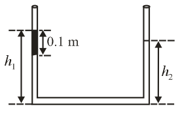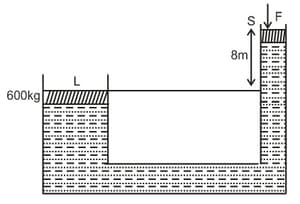Which principle works on hydraulic lift?
Important Questions on Thrust and Pressure
Given below are two statements: one is labelled as Assertion A and the other is labelled as Reason R
Assertion A: When you squeeze one end of a tube to get toothpaste out from the other end, Pascal’s principle is observed.
Reason R: A change in the pressure applied to an enclosed incompressible fluid is transmitted undiminished to every portion of the fluid and to the walls of its container.
In the light of the above statements, choose the most appropriate answer from the options given below.
[Take surface tension of water , angle of contact and density of water
An open-ended U-tube of uniform cross-sectional area contains water (density ). Initially the water level stands at from the bottom in each arm. Kerosene oil (a water-immiscible liquid) of density is added to the left arm until its length is , as shown in the schematic figure below. The ratio of the heights of the liquid in the two arms is

(Acceleration due to gravity )
A hydraulic automobile lift is designed to lift cars with a maximum mass of . The area of cross section of the piston carrying the load is . What maximum pressure would the smaller piston have to bear?

A hydraulic automobile lift has input and output pistons with diameters of and . The lift is used to hold up a car with a weight of . What pressure is applied on the input piston?

